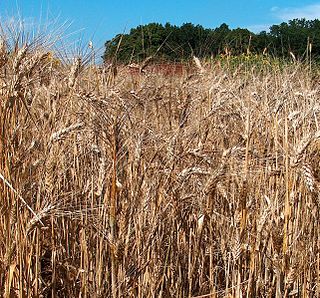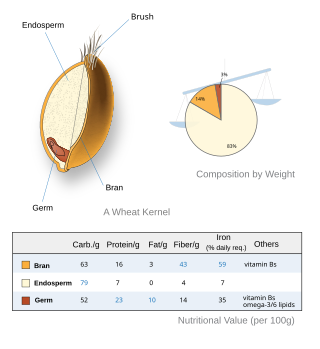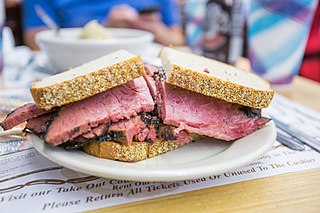
Matzah, matzo, or maẓẓah is an unleavened flatbread that is part of Jewish cuisine and forms an integral element of the Passover festival, during which chametz is forbidden.

Wheat is a grass widely cultivated for its seed, a cereal grain that is a staple food around the world. The many species of wheat together make up the genus Triticum ; the most widely grown is common wheat. The archaeological record suggests that wheat was first cultivated in the regions of the Fertile Crescent around 9600 BC. Botanically, the wheat kernel is a caryopsis, a type of fruit.

Flour is a powder made by grinding raw grains, roots, beans, nuts, or seeds. Flours are used to make many different foods. Cereal flour, particularly wheat flour, is the main ingredient of bread, which is a staple food for many cultures. Corn flour has been important in Mesoamerican cuisine since ancient times and remains a staple in the Americas. Rye flour is a constituent of bread in both Central Europe and Northern Europe.

Porridge is a food made by heating or boiling ground, crushed or chopped starchy plants, typically grain, in milk or water. It is often cooked or served with added flavourings such as sugar, honey, fruit, or syrup to make a sweet cereal, or it can be mixed with spices, meat, or vegetables to make a savoury dish. It is usually served hot in a bowl, depending on its consistency. Oat porridge, or oatmeal, is one of the most common types of porridge. Gruel is a thinner version of porridge and congee is a savoury variation of porridge of Asian origin.

A grain elevator is a facility designed to stockpile or store grain. In the grain trade, the term "grain elevator" also describes a tower containing a bucket elevator or a pneumatic conveyor, which scoops up grain from a lower level and deposits it in a silo or other storage facility.

Durum wheat, also called pasta wheat or macaroni wheat, is a tetraploid species of wheat. It is the second most cultivated species of wheat after common wheat, although it represents only 5% to 8% of global wheat production. It was developed by artificial selection of the domesticated emmer wheat strains formerly grown in Central Europe and the Near East around 7000 BC, which developed a naked, free-threshing form. Like emmer, durum wheat is awned. It is the predominant wheat that grows in the Middle East.

Semolina is the name given to coarsely milled durum wheat mainly used in making pasta and sweet puddings. The term semolina is also used to designate coarse millings of other varieties of wheat, and sometimes other grains as well.

Chinese noodles vary widely according to the region of production, ingredients, shape or width, and manner of preparation. Noodles were invented in China, and are an essential ingredient and staple in Chinese cuisine. They are an important part of most regional cuisines within China, and other countries with sizable overseas Chinese populations.

Pumpernickel is a typically dense, slightly sweet rye bread traditionally made with sourdough starter and coarsely ground rye. It is sometimes made with a combination of rye flour and whole rye grains.

White bread typically refers to breads made from wheat flour from which the bran and the germ layers have been removed from the whole wheatberry as part of the flour grinding or milling process, producing a light-colored flour.

A whole grain is a grain of any cereal and pseudocereal that contains the endosperm, germ, and bran, in contrast to refined grains, which retain only the endosperm.

Rye bread is a type of bread made with various proportions of flour from rye grain. It can be light or dark in color, depending on the type of flour used and the addition of coloring agents, and is typically denser than bread made from wheat flour. Compared to white bread, it is higher in fiber, darker in color, and stronger in flavor. The world's largest exporter of rye bread is Poland.

Wheat Thins is a brand of baked whole grain snack food crackers distributed in the United States and Canada by Mondelez International. The product is also available in Australia through wholesaler USA Foods. Vegetable Thins, Oat Thins, Pita Thins, and Rice Thins, which are all spinoffs of Wheat Thins, are available in Canada and some regions of the United States. Wheat Thins themselves come in many flavors and varieties. Nabisco first introduced the product in 1947.
A millstone is a stone used in gristmills, for grinding wheat or other grains.
The grain trade refers to the local and international trade in cereals such as wheat, barley, maize, and rice, and other food grains. Grain is an important trade item because it is easily stored and transported with limited spoilage, unlike other agricultural products. Healthy grain supply and trade is important to many societies, providing a caloric base for most food systems as well as important role in animal feed for animal agriculture.

The Saskatchewan Wheat Pool was a grain handling, agri-food processing and marketing company based in Regina, Saskatchewan. The Pool created a network of marketing alliances in North America and internationally which made it the largest agricultural grain handling operation in the province of Saskatchewan. Before becoming Viterra, SWP had operated 276 retail outlets and more than 100 grain handling and marketing centres. The Saskatchewan Wheat Pool operated under the name of AgPro in the prairie provinces of Manitoba and Alberta. Begun as a co-operative in the 1920s, the company became a publicly traded corporation in the 1990s. After the 2007 takeover of its competitor, Winnipeg-based Agricore United, the Pool name was retired. The merged company operated under the name Viterra until 2013, when it was acquired by Glencore International.
Corn most often refers to maize, the yellow, large-grained crop native to the Americas.

A grain is a small, hard, dry fruit (caryopsis) – with or without an attached hull layer – harvested for human or animal consumption. A grain crop is a grain-producing plant. The two main types of commercial grain crops are cereals and legumes.

Jewish rye bread is a type of rye bread commonly made in Jewish communities. Due to the diaspora of the Jews, there are several geographical variations of the bread. The bread is sometimes called sissel bread or cissel bread, as sissel means caraway seed in Yiddish.















